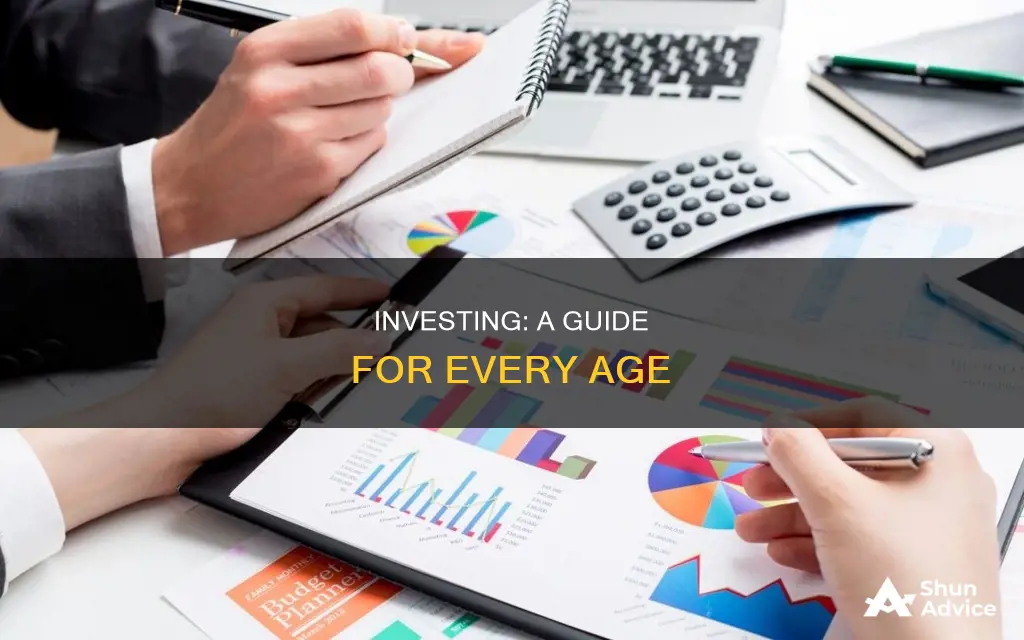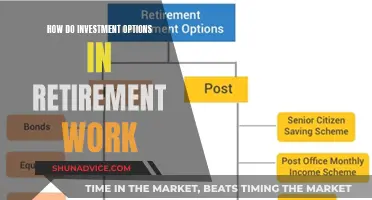
Investing is a challenging process that requires focus and discipline. It is important to start investing early and consistently, and to have realistic expectations. The earlier one starts putting money away, the less one will have to contribute later, thanks to the power of compounding.
Young investors have time on their side, and can afford to take more risks with their investments, which will help them maximise their returns over time. However, it is important to have realistic expectations – not every investment will deliver a 50% return.
As people age, their investment strategy will likely change. They may be more comfortable exposing themselves to risk when younger, but as they get older, they might prefer a more conservative asset allocation.
What You'll Learn

How to invest in your 20s
Your 20s are a fantastic time to begin investing for retirement. You can be more aggressive with your investments at this age, leaning more heavily on higher-risk assets, such as stocks, which may deliver a higher rate of return than bonds or cash.
Priorities
While in your 20s, your top priorities should be paying off any student loans or credit card debt and building up your emergency fund.
Where to Invest
One of the easiest ways to begin investing is to sign up for your employer’s 401(k) plan, if they offer one. This type of retirement account allows you to put money from your paycheck away toward your retirement before taxes are taken out. You choose how those funds are invested, and you can change that allocation as you go. Some employers match their employees’ contributions to the plan up to a certain percentage, so you have even more money to invest.
How Much to Invest
If your employer does not offer a 401(k) or if you are already contributing the maximum percentage your employer will match, check into opening a traditional or Roth individual retirement account (IRA). Alternatively, you can invest in a 403(b) plan, which is similar to a 401(k) but offered to certain educators, public employees, and employees of nonprofits.
How Much to Contribute
A general rule of thumb is to invest 10% of your annual income for retirement. However, if you are unable to contribute this amount, invest what you can. You can also follow the guideline of earmarking 15% of your income for retirement when you're in your 20s.
Other Considerations
Building your financial foundation is important, too. This includes creating a budget that works, building your emergency fund, tracking your credit score, and paying down high-interest debt.
Shark Tank: Payback Time?
You may want to see also

How to invest in your 30s
By your 30s, you should ideally have the equivalent of your current annual salary saved. If you don't, don't panic—the best time to start investing is now. Aim to invest 15% of your income, but start where you can and increase the amount you save each year.
Your 30s are a time when you might be more focused on career growth and increasing your income. You may also be prioritising mortgage payments or starting a family, but it's important to continue investing. With years to go before retirement, your investments can still withstand a moderate amount of risk.
Diversifying your portfolio can help protect you from potential losses. T. Rowe Price suggests an allocation of 90% to 100% stocks, with bonds making up the remainder.
Eliminating debt will help you reach your savings goals. Paying off accounts frees up money that can be put towards investments. It's also important to strengthen your emergency fund, with experts recommending you have three to six months' worth of expenses on hand.
Other Investment Options
As well as stocks and bonds, there are other investment options to consider.
- Real estate: This can be a solid investment if you plan to stay in one place for more than five years. You could invest in a personal residence or a REIT (real estate investment trust).
- IRAs: A Roth IRA is a special individual retirement account where you pay taxes on contributions, and then all future withdrawals are tax-free.
- Employer-sponsored retirement plans: These often provide matching contributions, giving your retirement savings a boost.
- College savings plans: These allow you to put money away for higher education, and the funds can be allocated among various investment choices and will grow tax-free.
- Coverdell Education Savings Accounts: This type of college savings account allows you to take a more self-directed approach to your investments.
- Savings bonds: These are a good option for conservative investors who don't want to risk their principal. The interest earned on US savings bonds is also tax-free if used for higher education expenses.
- Money market funds, savings accounts, and short-term CDs: These are good options for your short-term cash and can provide safety and liquidity.
Why Invest in Entertainment?
You may want to see also

How to invest in your 40s
Now in your 40s, retirement should be one of your top priorities. You still have time before you start withdrawing from your retirement account(s), but this is the ideal time to build up your portfolio and ensure you're on track to meet your goals.
Your risk tolerance begins to shift more noticeably in your 40s. While you can still place some of your funds into more aggressive investments, you should be diligent in doing your research first. Make sure you're putting your money into assets with solid track records of returns, and don't take unnecessary chances. It will be much harder for you to recover from a loss now than it would have been in your 20s or 30s, and you may find it more difficult to bounce back.
Your asset allocation may begin pulling away from high-risk investments in favour of safer securities. This can include bonds, certificates of deposit (CDs) and money market accounts. PNC Financial Services suggests an asset allocation of 60% to 70% stocks and 30% to 40% bonds.
If you're able, maxing out your retirement accounts can help supercharge your nest egg. In 2023, you can contribute up to $22,500 to a 401(k) and $6,500 across all individual retirement accounts (IRAs).
Contributing to a health savings account (HSA) is another way to prepare for the future. The money you put in is tax-deductible, reducing your taxable income today. Withdrawals aren't taxed either, as long as the money is used to cover qualified medical expenses. Once you turn 65, you can use HSA funds for anything you want. Just bear in mind that the IRS considers non-qualified distributions taxable income.
The big goal is to have three times your annual salary saved by age 40.
Middle-Aged Investors: Saving Enough?
You may want to see also

How to invest in your 50s
When you're in your 50s, retirement is no longer a distant prospect, so it's important to ensure your finances are in order. Here are some steps to help you invest wisely during this decade of your life:
Understand your financial situation
Get a clear understanding of your assets, liabilities, income, and expenses. This will help you assess whether you're on track to meet your financial goals. Calculate your net worth by subtracting what you owe (e.g., debt, mortgage, credit card balances) from what you own (e.g., cash, retirement accounts, assets). Knowing your financial status will help you make informed decisions about your retirement journey.
Reflect on your retirement goals
Consider your ideal retirement lifestyle. How do you want to spend your time? What hobbies do you want to pursue? Where do you want to go and who do you want to spend time with? Answering these questions will give you a clearer idea of how much money you'll need, which will inform your saving and investment strategies.
Make a plan for your long-term care
It may seem early, but your 50s are a beneficial time to start planning for potential long-term care needs. If you decide you want insurance, starting early means your health may be better, giving you more time to spread out premiums. Planning early also gives you more time to discuss your care preferences with loved ones, ensuring your wishes are met.
Review and adjust your investment portfolio
As you get closer to retirement, you may want to take on less risk with your investments. While growth is still important to keep up with inflation, you'll also want to consider investments that provide more stability and income. This may include investing more in stable stocks, government and investment-grade bonds, and cash. Review your portfolio regularly with a financial advisor to ensure it aligns with your life stage and long-term goals.
Take advantage of catch-up contributions
With retirement approaching, make sure you're saving enough by taking advantage of "catch-up" contributions. For example, in 2024, the contribution limit for a 401(k) is $23,000, but those over 50 can contribute an additional $7,000, for a total of $30,500. Similarly, the contribution limit for an IRA is $7,000, with an extra $1,000 available for those 50 and older, totaling $8,000.
Understand your healthcare options
Healthcare expenses are almost inevitable during retirement. Research the best healthcare plans for your needs, as Medicare may not cover everything. Consider supplemental insurance policies to cover any gaps. Additionally, a health savings account (HSA) offers unique tax breaks, making it easier to cover healthcare costs in retirement.
Seek professional advice
Meeting with a financial advisor can be a crucial step in ensuring you have a solid retirement plan. They can help address any concerns and ensure you're on the right path to achieving your retirement goals. Regular meetings with an advisor can provide peace of mind and guidance as you navigate this important decade of financial planning.
Goldman Sachs: Applications Flood In
You may want to see also

How to invest in your 60s
As you enter your 60s, it's a good idea to take your financial temperature and assess whether you need to make any catch-up retirement contributions. You might also consider downsizing your lifestyle to save more for retirement, such as by selling your home and moving into a smaller property.
When it comes to your asset allocation, a conservative approach may be more comfortable. A 50/50 split between stocks and bonds could be a good strategy at this stage. A financial professional can help you decide on the best approach for your circumstances.
As you get closer to retirement, think about your future income sources. These might include Social Security benefits (waiting until your full retirement age will increase your benefit), the cash value of a permanent life insurance policy, and annuities.
Remember that different accounts are taxed differently. For example, distributions from 401(k)s and traditional IRAs are taxable, whereas withdrawals from Roth accounts are tax-free. To be strategic, pull funds in the most tax-efficient way to avoid unexpected tax bills that deplete your savings.
Finally, rebalancing your portfolio throughout retirement is important. If left unchecked, your investments could drift into riskier territory. Rebalancing involves resetting your portfolio to your desired asset allocation.
Fidelity's Investor Numbers
You may want to see also
Frequently asked questions
People in their 20s should focus on paying off any student loans or credit card debt and building an emergency fund. It is also a good time to start investing for retirement. As a young person, you can be more aggressive with your investments, leaning more heavily on higher-risk assets such as stocks, which may deliver a higher rate of return than bonds or cash.
In your 30s, you might be more concerned with mortgage payments or the costs of starting a family and saving for your children's education. You might also be further ahead in your career and earning more money. This is a good time to increase the amount you are investing. Your investments can still withstand a moderate amount of risk, but you may want to allocate more to conservative assets such as bonds.
Retirement should be a top priority in your 40s. Your risk tolerance begins to shift, so while you can still place some funds into aggressive investments, you should be diligent in researching first. Make sure you are putting your money into assets with solid track records of returns, and don't take unnecessary chances.
With retirement approaching, you may want to take a more conservative approach to investing. A stock market loss could be catastrophic for your savings, so it's time to scale back on higher-risk assets. You should also start drawing up a detailed retirement plan and budget to ensure you are on track.
If you haven't retired by this age, keep investing! Your investment strategy should shift away from growth and instead focus on making your money last. Focus on stocks that provide dividend income and add to your bond holdings.







